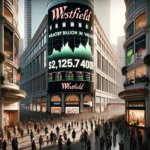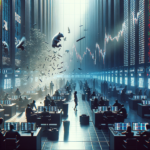Impact of Westfield Mall’s Valuation Decline on San Francisco’s Retail Landscape
San Francisco’s Westfield mall, a bustling hub of retail activity and a beacon of urban consumerism, has recently experienced a staggering devaluation. The once-thriving shopping center, which has graced the heart of the city for years, has seen its value slashed by an astonishing 75%, effectively erasing nearly $1 billion from its valuation. This dramatic downturn has sent ripples through the city’s retail landscape, prompting a reevaluation of the future of brick-and-mortar stores in an increasingly digital world.
Despite the stark numbers, there is a silver lining to this financial cloud. The decline in valuation is not just a story of loss and decay but also one of adaptation and potential rebirth. San Francisco, known for its resilience and innovation, is poised to use this moment as a catalyst for change and a reimagining of its retail environment.
The Westfield mall’s devaluation can be attributed to a confluence of factors, including the rise of e-commerce, changing consumer behaviors, and the economic fallout from the COVID-19 pandemic. These challenges have forced traditional retailers to rethink their strategies and adapt to a new normal where online shopping has become increasingly prevalent. However, this shift also presents an opportunity for retailers to innovate and create new experiences that can draw people back into physical stores.
In response to the changing landscape, San Francisco’s retail sector is beginning to embrace a more experiential approach. Retailers are now focusing on creating unique in-store experiences that cannot be replicated online. From interactive displays to pop-up events and workshops, the goal is to make shopping a more engaging and enjoyable activity. This strategy aims to leverage the social and tactile aspects of shopping that e-commerce cannot provide, thus giving physical stores a competitive edge.
Moreover, the devaluation of the Westfield mall could lead to a diversification of the retail mix in the area. With lower property values, there is an opportunity for new and emerging brands to establish a presence in the city. This influx of fresh retail concepts can invigorate the shopping scene and attract a broader demographic of consumers. The potential for a more eclectic and vibrant retail offering is exciting for both shoppers and businesses alike.
The city’s commitment to supporting local businesses also plays a crucial role in the revitalization of the retail sector. Initiatives aimed at promoting San Francisco-based retailers can help create a unique shopping environment that celebrates local culture and entrepreneurship. By fostering a strong community of local businesses, the city can create a distinctive retail ecosystem that differentiates it from other shopping destinations.
Furthermore, the revaluation of such a significant property as the Westfield mall could have a positive impact on the city’s real estate market. It may lead to more realistic pricing and encourage investment in underutilized spaces, potentially spurring development and economic growth in the surrounding areas.
In conclusion, while the sharp decline in the Westfield mall’s valuation is a significant blow to San Francisco’s retail landscape, it is not the end of the story. The city is known for its ability to evolve and thrive in the face of adversity. By embracing change and fostering innovation, San Francisco can turn this challenge into an opportunity to create a more dynamic, diverse, and resilient retail environment. The future of shopping in the city is not just about transactions; it’s about experiences, community, and the spirit of reinvention that has always defined San Francisco.
Analyzing the Economic Factors Behind Westfield San Francisco’s $1 Billion Value Drop
San Francisco’s Westfield mall, once a bustling hub of retail activity and a symbol of urban consumerism, has seen its value plummet by a staggering 75%, erasing nearly $1 billion from its valuation. This dramatic drop is a stark indicator of the shifting economic landscape and the challenges facing brick-and-mortar retail in the digital age.
The decline in the mall’s value can be attributed to a confluence of factors that have reshaped consumer behavior and the retail environment. The rise of e-commerce has been a significant disruptor, as online shopping offers convenience and often lower prices, drawing customers away from traditional in-store experiences. Giants like Amazon have set a new standard for retail, forcing physical stores to adapt or face obsolescence.
Moreover, the COVID-19 pandemic has accelerated these trends, as lockdowns and health concerns have pushed even more consumers to shop online. The pandemic has also led to a reevaluation of priorities, with many people opting for experiences over material goods, further impacting retail sales. As a result, foot traffic in malls across the country has dwindled, and San Francisco’s Westfield mall has not been immune to this decline.
Despite these challenges, there is a silver lining. The devaluation of Westfield mall presents an opportunity for reinvention and innovation. Retailers and property owners are now compelled to rethink their strategies and create new experiences that can attract consumers back to physical stores. This could involve integrating technology to enhance the shopping experience, offering exclusive in-store products, or hosting events that turn shopping into a social and entertainment activity.
Furthermore, the mall’s prime location in the heart of San Francisco makes it an ideal candidate for mixed-use development. By diversifying the space to include residential units, offices, or cultural venues, the property can generate new streams of revenue and become a vibrant community hub. This approach aligns with the broader trend of urban revitalization, where mixed-use developments are seen as a way to create more dynamic and sustainable urban centers.
The city of San Francisco itself is a resilient economy with a strong foundation in technology and innovation. This culture of innovation can be harnessed to transform the Westfield mall into a forward-thinking destination that reflects the city’s character. Retailers that can leverage technology and offer unique, personalized experiences have the potential to thrive in this new environment.
In addition, the mall’s devaluation could make it more accessible to a wider range of tenants, including local businesses and startups that may have previously been priced out of such a prime location. This could lead to a more diverse and eclectic mix of retailers, further enhancing the appeal of the mall to consumers looking for something different from the standard retail fare.
In conclusion, while the sharp decline in the value of San Francisco’s Westfield mall is indicative of the broader challenges facing the retail sector, it also opens the door to exciting possibilities. By embracing change and innovation, the mall can reinvent itself as a destination that meets the evolving needs and desires of consumers. With a spirit of optimism and a willingness to adapt, the future of Westfield mall, and indeed retail in general, can be bright and prosperous.







